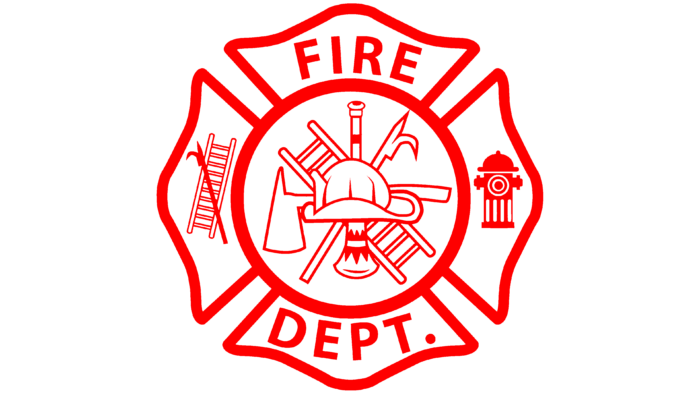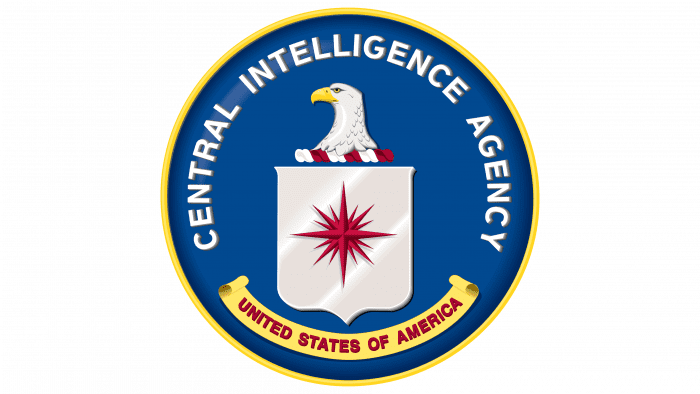Everything you need to put out a fire is in the Fire Department logo. The emblem demonstrates composure, readiness to leave on demand, and the teamwork of firefighters. Since its founding, the department has been determined to fight against the elements.
Fire Department: Brand overview
| Founded: | 1906 |
| Headquarters: | United States |
Meaning and History
Many public fire departments in the United States operate within the country, state, county, or individual localities. There are also specialized and private organizations. They may be crewed by volunteers or professionals. The only thing they all have in common is a firefighter logo in the shape of a cross.
Now it is commonly thought that the Fire Department logo depicts the Maltese cross: an eight-pointed figure of four V-shaped elements connected at the center of the sharp angles. This cross was borrowed from the Knights Hospitallers, who decorated their armor to distinguish each other on the battlefield. Metal plates completely covered warriors’ faces, so they did not understand who was an associate or an enemy in front of them.
During battles, the knights involuntarily had to put out fires because their main adversaries, the Saracens, had learned to use fire as a weapon. So they earned the title of firefighters, and the Maltese cross became a symbol of protection. According to historical records, it was first adopted as the emblem of the New York Fire Department in the mid-1860s.
According to another version, the firefighter logo depicts an entirely different sign, the Florian cross. It is more consistent in form because it consists of four shaped “petals” lined up along a circular center. This eight-pointed cross appeared in the 4th century when a Roman officer Florian created several fire brigades on behalf of the army leadership. They were not the only ones, but the best in the city. Florian was executed because of his religious views, and later Christians recognized him as a saint. He is now the world-famous patron saint of firefighters.
The Fire Department symbol is more similar in structure to the Florian cross than the Maltese cross. It consists of four separated parts, which contain two rounded corners. At the top is the white word “FIRE,” and at the bottom is “DEPT,” with a square dot at the end. The above-ground fire hydrant is shown on the left, and the right “petal” contains a ladder and a bugle.
The center circle is occupied by a whole set of firefighting equipment, including a helmet, ax, and horn, which was used in the olden days to signal fires. In the background, you can see the crossed bugles and ladder, but they look different from the similar elements on the right side. First, they are not three-dimensional but two-dimensional. Secondly, they do not have black hooks on their ends.
Fire Department: Interesting Facts
- Modern Fire Engine: Invented in 1905, the modern fire engine equipped with pumps, hoses, and ladders greatly improved firefighting. Springfield was the first to use it in 1906, revolutionizing fire services.
- Volunteer and Professional Firefighters: Fire departments vary between volunteer and professional firefighters. Smaller communities often rely on volunteers for their firefighting needs, while larger cities have full-time, paid firefighters.
- Beyond Fighting Fires: Today’s firefighters are often the first on the scene for emergencies like medical issues, car accidents, and natural disasters, playing a key role in emergency medical services.
- Training and Expertise: Firefighters receive extensive training in fire suppression and specialized areas like rescue operations and handling hazardous materials, ensuring they’re prepared for various emergencies.
- Safety Standards: The National Fire Protection Association (NFPA), founded in 1896, develops fire safety codes and standards that influence fire prevention strategies and public safety measures.
- Dalmatians as Mascots: Historically, Dalmatians worked with horse-drawn fire engines to clear paths and protect equipment. They no longer serve this function but remain a fire department symbol.
- 911 Emergency Number: The introduction of 911 in 1968 streamlined emergency reporting and response, allowing quicker service dispatch.
- The 9/11 Effect: The 9/11 attacks had a profound impact on fire departments, especially the FDNY, leading to changes in safety policies and a greater focus on counter-terrorism.
- Wildland Firefighting: Fire departments in wildfire-prone areas have specialized teams that battle forest fires using different techniques from those used in urban settings.
- Community Engagement: Fire departments work on prevention through community education, teaching safety practices, and reducing fire risks.
- Equipment Advances: Technological advancements have led to better firefighting equipment, like thermal imaging cameras for rescue missions and drones for assessing wildfires and conducting search and rescue.
The evolution of fire departments showcases their adaptability to new challenges and technologies. They are constantly focused on protecting and serving the community.
Font and Colors
The name of the Fire Department is written in large white letters without serifs. Only the bottom of the “R” has a small resemblance to a serif. The font is bold, uppercase, and noncontrasting. The lower horizontal stroke of the “F” is slightly shortened, as is the middle line of the “E.”
Red and white are the traditional colors of the fire department in the United States. The logo is complemented by gold and black, the latter being used mainly for outlines so that the elements are better visible and don’t blend.
Fire Department color codes
| Lust | Hex color: | #ed190d |
|---|---|---|
| RGB: | 237 25 13 | |
| CMYK: | 0 90 95 7 | |
| Pantone: | PMS 172 C |
| Indian Yellow | Hex color: | #e1a047 |
|---|---|---|
| RGB: | 225 160 71 | |
| CMYK: | 0 29 68 12 | |
| Pantone: | PMS 1365 C |
| Black | Hex color: | #000000 |
|---|---|---|
| RGB: | 0 0 0 | |
| CMYK: | 0 0 0 100 | |
| Pantone: | PMS Process Black C |





